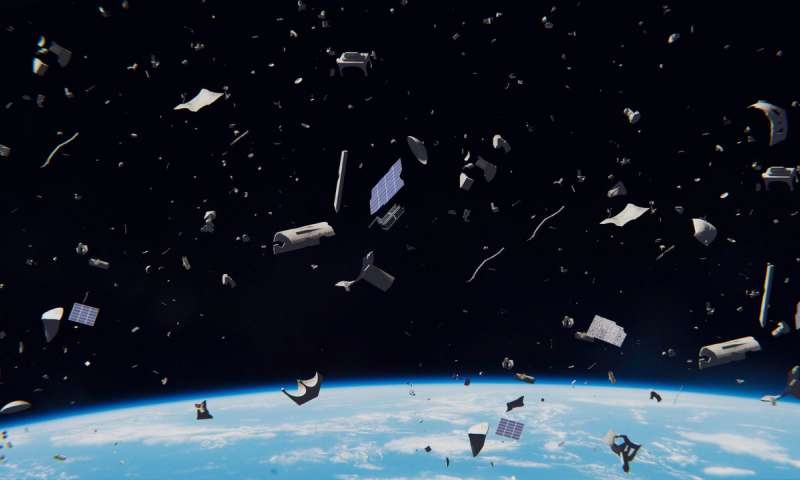Satellites might not be visible for the human eye during the day and often not by night, but they have a pivotal role in sharing information. Without even realising it, humans are dependent on satellites with multiple daily activities. From watching television, to checking the weather forecast on an application and sharing locations with your friends on Snapchat, they would not function without the current technology in space. With the commercial exploitation of space, the number of objects orbiting around the world is over 23.000 and still growing exponentially (Liou, 2016). This creates seemingly endless opportunities, but dark times might be lurking around the corner and this will cost the satellite dependent companies a lot of money.
Since the technology that is shot to space is often a one-way trip, it is doomed to fly there in eternity. Of the 23.000 objects only 12.000 are in active use, leaving the rest to what is known as space debris and collectively space junk. This junk contributes nothing to any business or society, and it can be concluded that space is not used cost efficiently. Furthermore, the space debris can collide, with each other or operating objects, which they start to do more frequently (Liou, 2016).
There are over 500 accidents with space debris, which account for 2% of the entire population but is expected to grow since the probability of collisions increases with the number of items in space (Braun et al., 2017). This implicates that companies dependent on the satellites are not able to operate or not with full capacity. To illustrate the consequences with an example: one of DigitalGlobe’s satellites, the WorldView-4, generates 85 million dollars of revenue for the company. The satellite broke down at the beginning of this year and could not operate. Because of that the company was not able to sell their service to their clients, like GoogleMaps, which resulted in a loss of revenue. Furthermore, the insurance costs of the satellites were 183 million, which lead to major loss of almost 100 million dollars, even without the unearned revenue (Grush, 2019). Fortunately for DigitalGlobe, the accident was no collision when even more costs could have incurred.
In the case of a collision, another factor becomes important: responsibility. Since there are legislation around space is still premature, responsibility and with that accountability is hard to determine. The fact that companies from different countries operate in space, makes it hard to determine a place for jurisdiction. With that, the prediction of space lawsuits is not bright. Because of the mentioned factors, the estimated costs for lawsuits in space are higher because of the complexity (Chrystal, 2011).
It can be concluded that the commercial space exploitation created a thriving scene for information sharing technologies. However, the growing crowd in space also has some downsides. The collisions and breaking down of satellites can eat away major sum of a company’s funds. Furthermore, the additional costs of complex lawsuits will attack these funds as well. Humans are getting more and more dependent on satellites but there is probably a price to pay.
References:
Braun, V., Horstmann, A., Reihs, B., Lemmens, S., Merz, K., & Krag, H. (2019). Exploiting Orbital Data and Observation Campaigns to Improve Space Debris Models. The Journal Of The Astronautical Sciences, 66(2), 192-209. doi: 10.1007/s40295-019-00155-6
Chrystal, P. (2011). On collision course for insurers? [PDF]. Retrieved from https://www.swissre.com/dam/jcr:b359fb24-857a-412a-ae5c-72cdff0eaa94/Publ11_Space+debris.pdf
Grush, L. (2019). Fixing broken satellites in space could save companies big money. Retrieved 25 September 2019, from https://www.theverge.com/2019/1/10/18173600/worldview-4-satellite-servicing-repair-gyroscope-space
Liou, J. (2019). Growth of Orbital Debris [PDF]. Singapore: NASA. Retrieved from https://ntrs.nasa.gov/search.jsp?R=20160012733


Very interesting post that both captures and analyses the problem.
In daily life, climate change and sustainability are two predominant factors of pollution. Hence, people are usually not aware in what terms space objects can contribute to pollution since they are far from recyclable. For future exploration, the question of how to create a sustainable orbit arises. Future innovations can be for example space extractor or reusable satellites with in-out possibilities. Besides that, in case of collision or the loss of a satellite, maybe there are possibilities for insurance on space satellites. Furthermore, I understand the legal problems regarding space territory. Maybe an official permission to shoot satellites in orbit or an universal space law could be interesting future discussion points.
Interesting topic! The question that arises is whether there are solutions to reduce and/or control the amount of junk circulating in space. At the moment, one of the concepts in development to control space junk often sound more like science fiction. JAXA, Japan’s space agency, is testing an electronic space whip that stretches six football fields long. When deployed, it’s intended to knock debris out of orbit, sending it to burn up in Earth’s atmosphere. Other options include giant magnets, harpoons and nets to safely reduce the growing space debris cloud.
Concluding, people and companies have come up with certain solutions, but how long will it take before these science fictional ideas become reality?
https://www.nationalgeographic.com/science/space/reference/space-junk/